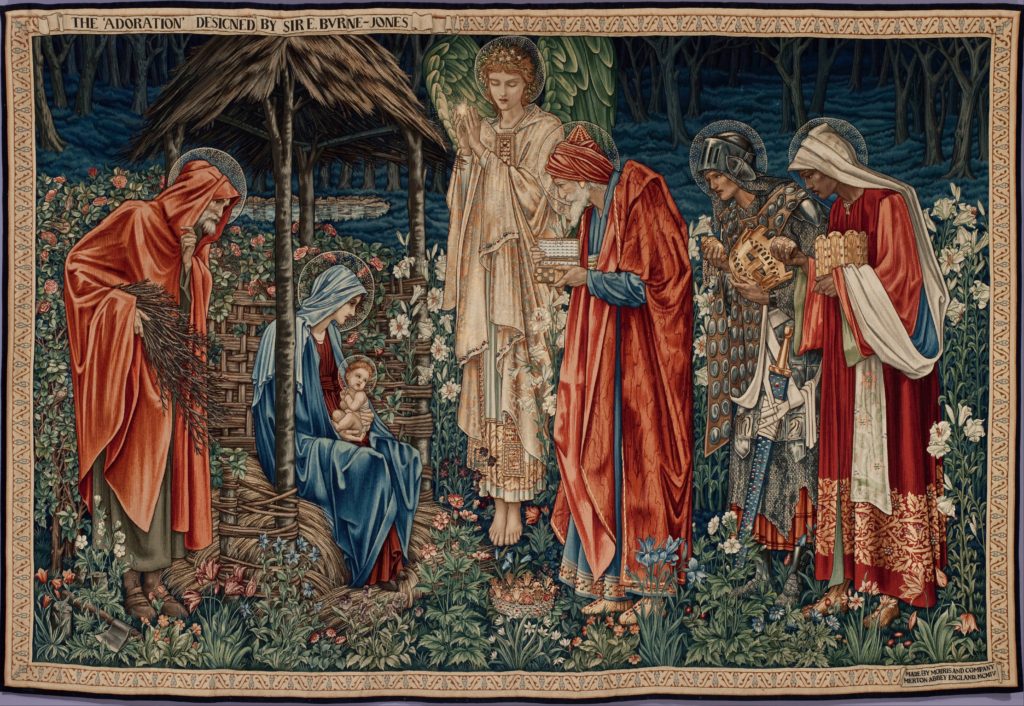
January 6th is the traditional Feast Day of the Epiphany celebrating the nativity of our Lord Jesus Christ, his revelation to the Gentile world (i.e., the three Magi), and the twelve days of Christmas. Technically, the Feast was celebrated this year on Sunday January 3rd in order to foster greater participation, yet the 6th as the traditional and official date remains. Epiphany comes from the Greek epiphaneia meaning manifestation or appearance. The Epiphany, then, is the celebration of the appearance, or the manifestation, of Christ born into the flesh. St. Paul uses the word epiphaneia in regard to the Incarnation: “and now has manifested through the appearing of our Savior Christ Jesus.” (2 Tim. 1:10) Epiphaneia is also applied several times in reference to the Second Coming of Christ, for example: “And then the lawless one will be revealed, and the Lord Jesus will slay him with the breath of his mouth and destroy him by his appearing and his coming.” (2 Thess. 2:8) Jesus appears in his first epiphaneia in his First Coming in the Incarnation, and will appear again in his second epiphaneia in his Second Coming.
God originally manifests himself in the Old Testament with his appearing, or epiphaneia, at Mount Sinai to establish the Mosaic Covenant with the Israelites. This original manifestation of Yahweh at Mount Sinai is his Theophany to the world. In Exodus, Moses describes the scene at Mount Sinai: “Now the appearance of the glory of the Lord was like a devouring fire on the top of the mountain in the sight of the people of Israel.” (Ex. 24:17) The “appearance” (the Hebrew word umareh) at Mount Sinai can be linked exegetically to the epiphaneia of the Incarnation, and ultimately, to the Second Coming.
Certain despotic rulers have through out history tried to usurp the divine epiphaneia for themselves. The Seleucid king Antiochus IV Epiphanes claimed divinity for himself with the name (Epiphanes) “God Manifest.” He reigned in the second century B.C. and subjected Israel to tyrannical rule. In 167 B.C., he ended the daily whole burnt offering in the Temple, sacrificed a pig on the Temple altar, and erected a statue to the Greek god Zeus. This is considered a fulfillment to the desolating abomination foretold by the prophet Daniel that he “shall take away the continual burnt offering. And they shall set up the abomination that makes desolate.” (Dan. 11:31) Many consider him to be a forerunner and prefigurement to the Antichrist. It was the Maccabean Revolt led by Judah Maccabee who ultimately overthrew the tyrannical king and his forces. A reading of the conclusion of the successful Maccabean Revolt states that they “were greatly gladdened by God’s manifestation.” (2 Macc. 15:27) The Septuagint calls the term “God’s manifestation” by the Greek word, again, epiphaneia. The epiphaneia of God ultimately trumped the false-epiphaneia of a corrupt ruler.
Now, we enter the Epiphany of our Lord Jesus Christ in January 2021. The world, much like at the time of Christ, and at the time of the Maccabees, is in crisis. We are still encumbered under the weight of the Chinese COVID-19 virus and pandemic. The national lockdowns in the United States led to a series of disastrous novelties in the election system, namely, greatly expanded usage of mail-in ballots. These provisions have been severely abused and misused under this pretext by the Democratic Party leadership to fraudulently steal the presidential election by targeting swing states (i.e., PA, GA, WI, MI, AZ, NV, NM). The proof is nearly indisputable now. (See the Georgia State Farm Arena security video for “Exhibit A”). Perhaps Providentially, the contested election is coming to a head on the traditional Feast Day of the Epiphany, January 6th. This is the day specified Constitutionally for the counting of Electoral votes by Congress. The question, then, becomes will the Vice President and Congress accept the fraudulent Biden Electoral votes from the swing states, or will they object to, challenge, and reject them? What, or who, has the Constitutional powers to do so?
There are many more questions than good answers at the moment. No one knows exactly how this will play out on January 6th, or up to, or even through, the Inauguration date of January 20th. One thing that may happen is that it only takes one Representative and one Senator to object to a slate of Electors from a contested state and that will spark a two-hour debate in Congress per each objection. Congress will be allowed to air, presumably, on national television, and over the internet for the whole world to see, all, or at least, some of the evidence of voter fraud perpetrated in this election. This fraud will be shown potentially to the whole world. Or, in other words, there may be an “epiphany” regarding what really happened on November 3, 2020 and beyond. There likely will not be an Epiphany (with a capital “E”) of God made manifest, like at Mount Sinai or in the Incarnation, but there may very well be an epiphany (“a revealing”) of the electoral theft that was perpetrated.
As thousands upon thousands of “Magabees” gather in Washington, D.C. on January 6th, it will become increasingly evident which direction this country’s future is headed. Will the Constitution and the rule of law prevail, or will the stealing of an election and a fraudulent President be allowed to stand? Will it be the Great Awakening or the Great Socialist Reset? Pray. Pray, because this is a both temporal and a spiritual struggle, as St. Paul warned us:
“For we are not contending against flesh and blood, but against the principalities, against the powers, against the world rulers of this present darkness, against the spiritual hosts of wickedness in the heavenly places.” (Eph. 6:12)
In humble recognition of the Savior’s Epiphany, pray very much that God will also have mercy upon the United States and that his divine grace will manifest (epiphaneia) among us.
